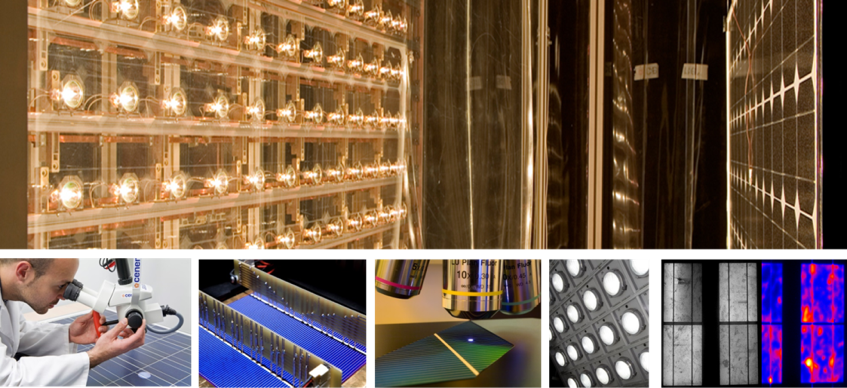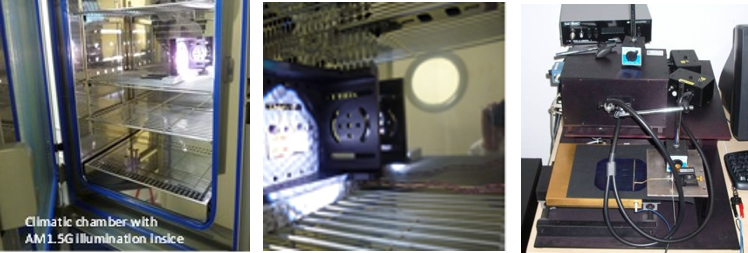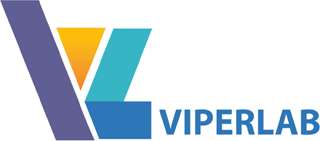- EC Accredited PV Module testing Lab
- State of the art equipment for the development and application of specific protocols to characterize photovoltaic devices based on organic or perovskite materials
- Custom-made stabilization, aging and reliability testing based on approved standards.
CENER is accredited by the Spanish National Accreditation Entity (ENAC) and also by the International Electrotechnical Commission (IEC) for testing PV modules according to ISO/IEC 17025:2017 General requirements for the competence of testing and calibration laboratories.
The accreditation scope covers IEC standards for all PV technologies: IEC-61215-1(all subparts), IEC61215-2, IEC-61730-(1&2) , IEC-62108, IECTS60804-1 (PID) and IEC TS 60904-13 (EL).
CENER is member of the IEC System for Conformity Assessment (IECEE Scheme) as Certification Body Testing Laboratory (CBTL) for PV modules. Equipment available are:
- flash solar simulator
- continuous solar simulator
- climatic chambers.
CENER has also the possibility of testing PV modules in outdoor conditions in Sarriguren and in Almeria when high dose and continuous radiation is required.
In addition, as a member of IEC’s technical committee, TC-82, CENER participates actively in normalization tasks included in working groups, WG-2 - Modules non-concentrating, WG-7 Concentrating PV modules, WG-3 systems and WG-8 Photovoltaic (PV) cells. Based on CENER’s normalization and certification knowledge, a set of good practices in characterizing solar photovoltaic devices based on organic and perovskites materials in relation with current available standards have been developed.
Apart from all the tests included in those standards and taking advantage of the experience gained through their application in many products of different technologies, degradation protocols based on accelerating aging tests ISOS (ISOS-D, ISOS-O, ISOS-L, ISOS-T and ISOS-LT) from Basic (level 1) to Advanced (level 3) combining humidity – temperature and radiation in climatic chambers and outdoor test can be implemented in order to study the degradation factors for emerging PV technologies.
All the equipment, tests and activities performed in the PV Module testing Lab of CENER are following requirements of ISO-17025 concerning calibration and operations.
Extra photos

Figure 1 Continuous sun simulator (up). Characterization of PV devices (down)

Figure 2 Stability testing of a PK device inside the climatic chamber (left) and spectral response equipment (right)
Services currently offered by the infrastructure
- Testing for performance and safety qualification of all PV module technologies: c-Si, thin film (Si based, CIGS, CdTe, OPV), CPV modules and other BOS components
- Testing for characterization and standard development of hybrid and organic based PV modules. All the ISOS protocols levels 1 to 3 for organic and perovskites. The lab has participated in two Round Robin tests inside EERA and Stablenextsol (COST) for perovskites.
- R&D and testing of new products with PV integrated
- PV modules characterization, analysis of defects and working conditions by means of imaging techniques (electroluminescence, lock-in thermography, etc.)
- Accelerating aging tests
- Tests corresponding to individual phases of the regulation and “made-to-measure” tests defined in order to assess prototypes or process modifications.
- Development of methodology for IV determination based on IEC TR 63228 ED1: Measurement protocols for photovoltaic devices based on organic, dye-sensitized or perovskite materials
To access under VIPERLAB Project
- Details on access: Desk availability, and support for accommodation
- Number of days spent typically at the infrastructure for an experiment: 3 days
- Unit of access (how many user visits are expected): 9 user visits; preparatory work will be done based on a form to be filled with the description of project and telco. For safety reasons, the user will be accompanied by the technician in charge of the laboratory during his/her stay or limited time if it is an expert on the subject.
- Remarks on integration of users into the scheduling of the RI: The priority of use of laboratory is based on CENER needs. Scheduling will be done after those needs are covered.
- Access costs via unit costs (a), actual costs (b), or a combination (c): option “b”, actual costs.
Support offered
Quality of scientific environment and user access: Technicians and researchers are used to R&D and very supportive. CENER´s ISO-17025 qualification requires service evaluation
Partecipation in others relevant Research Projects or activities connected to VIPERLAB
- ETFE-MFM, Development of multi-functional and flexible modules to illuminate façades and its demonstration (FP7- ENERGY–2012 -2.1.2). Development, evaluation and demonstration of a BIPV element based on ETFE which includes LED illumination and photovoltaic energy generation.
- DEPHOTEX, Development of Photovoltaic textiles based on novel fibres (FP7-NMP-2007-4.0.2). CENER worked in the TCO development, Ti metallization and full characterization of the textile-based PV modules obtained.
- SOLAR-TRAIN, PV module lifetime forecast and evaluation (H2020-MSCA-ITN-2016). The goal of this project is to develop novel, validated models for the service lifetime and energy prediction of PV modules and systems. CENER lead the Work Package related to the analysis of the PV module degradation modes.
- HESITSC, High Efficiency Silicon Based Tandem Solar Cell PV module (SOLAR-ERA.NET 2016- 2017). In this project, Swedish universities KTH-Royal Institute of Technology and Karlstad University, the Swedish start-up company Tandem Sun AB and CENER worked in developing a high efficiency c- Si based tandem solar cell (SiTSC) technology exploiting the innovative coherent III-V/Si heterojunction.
- AISOVOL, Solution for PV generation for its use as an alternative constructive material in edification (Spanish call: Retos Colaboracion 2019). The aim of the project is the experimental development, manufacturing and test of a lighter PV module, using plastic materials instead of glass.
Expertise



